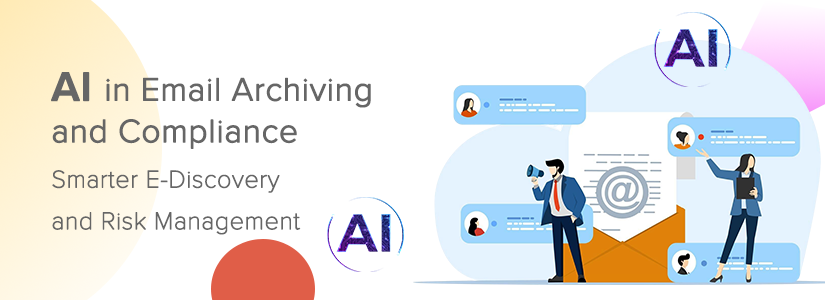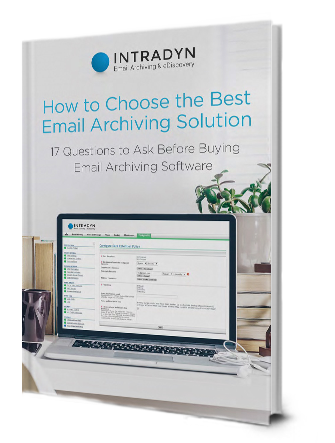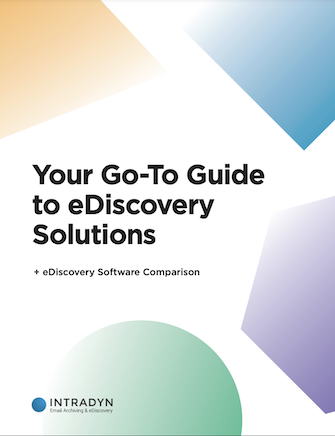AI in Email Archiving and Compliance: Smarter E‑Discovery and Risk Management

Every day, businesses send over 300 billion emails. As email continues to dominate business correspondence, it’s also become a key focus for regulators, auditors, and legal teams. Email archiving has evolved into a core tool for compliance and e‑discovery.
Artificial intelligence is taking it to the next level.
AI in email archiving and compliance is actively transforming the industry. It’s reshaping how companies manage risk, enforce compliance policies, and streamline legal workflows.
To dive deeper, here’s what we’ll cover in this blog:
- The growing compliance challenges organizations face
- How AI automates monitoring and policy enforcement
- AI’s role in streamlining e-discovery
- Using AI to detect anomalies and prevent insider threats
- What the future holds for AI in compliance and legal workflows
Why Email Archiving is Critical for Compliance
Compliance demands have reached unprecedented levels of sophistication and are more crucial. Across industries, organizations must navigate an intricate web of regulations: GDPR in Europe, HIPAA in healthcare, SOX in finance, FOIA in the public sector, and countless others.
Each regulation comes with its requirements around data retention, accessibility, and reporting. For many businesses, this means archiving years of email communications and being able to retrieve specific messages instantly.
Data must be verifiable, unchanged, complete, and managed according to company policies and legal requirements.
When this volume of data collides with growing compliance requirements, manual processes break down. Organizations are left struggling to keep up, leading to higher costs, greater time commitments, and labor remaining audit-ready.
How AI Improves Email Archiving and Compliance
Manual checks are slow and inconsistent. AI in email archiving and compliance enables a shift from reactive to proactive enforcement.
Using natural language processing (NLP) and machine learning, AI models can scan email content in real-time for patterns, anomalies, or policy violations. These models learn from past data and improve continuously, becoming more accurate over time.
For example, AI can detect:
- Leaked confidential information
- Unencrypted transmission of sensitive data
- Improper language or harassment indicators
- Policy violations such as non-disclosure breaches or unapproved financial discussions
Instead of relying on static keyword filters, AI adapts to context and usage. It can understand tone, recognize subtle changes in communication, and flag content that human reviewers might miss.
AI Alerts and Automation for Smarter Compliance
One of the most powerful aspects of AI-powered monitoring is its ability to trigger real-time alerts. When AI identifies a potential policy violation or risky behavior, it can automatically notify compliance officers, flag the email, or even initiate escalation workflows.
This reduces the response time to issues and ensures that problems don’t go unnoticed for days or weeks.
This approach creates a built-in documentation trail for audits and investigations, with time-stamped alerts and classifications that show your organization took appropriate action. By reducing the human workload, AI allows compliance teams to focus on strategy and oversight, not manual review.
AI in E-Discovery: Faster, Smarter Legal Search
When organizations are served with legal holds or discovery requests, time becomes the most valuable asset. Legal teams must swiftly locate and review specific communications while under tight deadlines and significant pressure.
Traditionally, this process required bulk exports, manual keyword searches, and line-by-line reviews. This approach proved time‑consuming, labor‑intensive, and susceptible to overlooking critical data.
AI fundamentally transforms this model
AI-powered e-discovery tools use clustering, classification, and predictive coding to analyze content, context, and intent.
These capabilities allow them to:
- Group related emails automatically
- Surface the most relevant messages first
- Weed out irrelevant content more effectively
- Identify emotionally charged or legally sensitive language
The result is faster case building, more accurate discovery, and a stronger legal position.
Technology-Assisted Review (TAR) and Predictive Coding
Technology-assisted review (TAR) is a legal review process that utilizes AI to identify relevant documents based on established patterns and user feedback.
Legal professionals classify messages as relevant or irrelevant, enabling the AI to learn from this input and automatically apply the feedback to the remaining documents. This accelerates the review process while improving consistency and defensibility.
Predictive coding takes this a step further by using training sets to classify documents at scale automatically. It minimizes the need for manual review while still maintaining legal integrity. AI elevates discovery from a time-consuming task to a smarter, more efficient process.
Reducing Legal Risk Through Smarter Discovery
Missing documents or inconsistent tagging during discovery can have serious legal repercussions, including fines, sanctions, or weakened legal positions. AI mitigates this risk by applying consistent logic across the entire dataset, eliminating subjective decisions and reducing errors caused by human fatigue.
Beyond accuracy, AI accelerates the review process by prioritizing the most relevant communications and automating repetitive tasks. This not only saves time and resources but also improves the defensibility of your discovery efforts.
AI continues to support compliance with data preservation obligations during legal holds by automatically identifying and locking relevant communications. This proactive approach ensures that no critical information slips through the cracks, giving legal teams confidence that they are fully prepared.
True compliance is achieved through proactive preparation. turning e-discovery into a strategic advantage rather than a reactive process.
AI for Anomaly Detection and Insider Threat Prevention
AI plays a critical role in detecting unusual behavior within email communications. By analyzing metadata, frequency, timing, and recipient patterns, AI models can identify activity that falls outside of the norm.
Key indicators are:
- Sudden spikes in outbound messages to unknown recipients
- Data sent to personal email addresses
- Access to archived content during odd hours
- Abnormal download volumes
By spotting irregular patterns and unusual activity, AI turns email archiving into an early warning system for potential risks. Detecting these issues before they escalate allows organizations to address threats proactively, protecting both compliance and reputation.
AI in Email Archiving for Governance and Audit Readiness
Modern AI is transforming email archiving from a passive storage solution into a powerful tool for compliance, risk management, and operational efficiency. By leveraging advanced analytics and automation, AI supports organizations in multiple key areas:
Sentiment and Behavioral Analysis
AI goes beyond technical monitoring to analyze the emotional tone and sentiment in emails. This capability, already applied in finance and government sectors, helps identify:
- Rising conflicts or hostile language
- Emotional distress in employee communications
- Early signs of toxic workplace dynamics
By detecting these behavioral signals early, organizations can enhance risk management, improve compliance monitoring, and anticipate potential challenges that traditional tools might overlook.
Retention and Governance Automation
Effective archiving demands more than secure storage; it requires strict enforcement of retention policies.
AI automates governance by:
- Classifying emails into policy-driven categories
- Flagging messages that require extended retention
- Automatically deleting content that meets expiration criteria
This automation ensures consistent enforcement, reduces liability, and prevents costly over-retention, all while lightening the burden on IT and compliance teams.
Regulatory Reporting and Audit Readiness
Generating reports for regulators, auditors, and leadership is one of the most time-consuming compliance tasks.
AI streamlines this process by automatically producing:
- Violation summaries and user activity logs
- Audit trails and retention policy adherence reports
- Tailored outputs that meet industry-specific requirements (e.g., SEC, FINRA, FOIA)
These intelligent reports not only reduce manual labor and improve accuracy but also keep organizations in a constant state of audit readiness while making compliance performance easier to communicate internally.
Ultimately, combining sentiment analysis, governance automation, and smart reporting, AI transforms email archiving into a proactive compliance engine. It reduces risk, saves time, and provides greater visibility into organizational data.
Ethical Considerations and Limitations of AI in Compliance
Although AI delivers significant efficiency improvements, it also raises ethical and legal considerations, especially in sensitive areas such as compliance, HR, and legal proceedings.
It’s essential to remember that AI is only as good as the data it’s trained on. If that data is biased, incomplete, or lacks context, the AI’s decisions may be flawed.
This becomes important when AI is used to flag potential violations or support legal discovery. Flagging safe communications as risky, or overlooking truly harmful ones, can lead to legal issues and diminish internal trust.
To mitigate these risks, organizations must:
- Ensure all AI-powered tools are explainable and transparent
- Train models on diverse, high-quality datasets
- Implement regular audits of AI decisions
- Maintain human oversight for sensitive actions
Responsible AI use requires balancing automation with accountability. Legal and compliance teams must collaborate with IT and data science to create systems that are effective, fair, defensible, and ethical.
A Look Ahead: What’s Next for AI in Compliance?
As AI technologies mature, we’ll see more sophisticated capabilities integrated into email archiving and compliance platforms.
Some of the most promising developments include:
1. Explainable AI (XAI)
Aids teams in understanding exactly why an AI model flagged a message. Essential for legal defensibility and audit transparency.
AI will extend beyond email to monitor chats, SMS, collaboration apps (Teams or Slack), and voice messages, creating a unified compliance ecosystem.
3. Predictive Compliance
AI could soon help organizations predict regulatory risks or identify emerging compliance trends based on communication patterns.
4. AI-Powered Case Building
Instead of pulling together emails manually for legal teams, AI could assemble the entire conversation trail and related documents automatically, saving time and reducing human effort.
Key Takeaways
- Organizations face growing compliance challenges under regulations including GDPR, HIPAA, and SOX, making manual email management unsustainable.
- AI scans email content in real time to detect sensitive data leaks, policy violations, and risky communications that human oversight might miss.
- Automated alerts and workflows respond instantly to flagged issues, reduce manual review time, and maintain clear audit trails.
- AI-powered e-discovery uses predictive coding and clustering to quickly find relevant emails, streamline reviews, and lower legal risk.
- Anomaly detection monitors unusual sending patterns and abnormal access times to help prevent insider threats.
- AI enforces email retention policies, automates governance tasks, and generates accurate audit and regulatory reports.
- Responsible AI with human oversight ensures transparency, fairness, and readiness for future multi-channel compliance needs.
Frequently Asked Questions (FAQ)
How does AI improve email compliance and reduce regulatory risk?
AI continuously scans email content and metadata to detect policy violations, sensitive data exposure, and compliance risks. Automating monitoring and alerting aids organizations to catch issues early, avoid fines, and maintain audit readiness.
What role does AI play in speeding up e-discovery for legal teams?
AI-powered e-discovery tools use predictive coding and clustering to quickly identify relevant emails, prioritize critical communications, and filter out irrelevant data. This accelerates legal reviews, reduces errors, and saves significant time and resources.
Can AI detect insider threats or unusual email activity in real time?
Yes. AI analyzes sending patterns, recipient behavior, and access activity to spot anomalies like mass email exports, off-hour logins, or emails sent to personal accounts. This proactive detection helps prevent data leaks and internal compliance breaches.
How does AI help organizations stay audit-ready and enforce retention policies?
AI automatically categorizes emails, applies retention schedules, and deletes expired data according to policy. It also generates audit-ready reports and documentation, ensuring consistent compliance with regulatory requirements.


